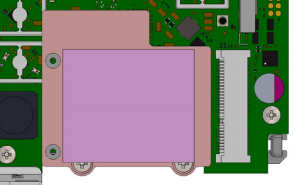...
Pictures added for illustration purposes, the device configuration, and the placement of the miniPCIe card may vary.
- Locate miniPCIe slot on your device;
- Unscrew two factory attached screws;
- Place thermal pad to the heat sink plateWe recommend using the thermal pad by placing it under the card, the thermal pad is not included in the package;
- Install the module to the miniPCIe slot and secure it with previously removed screws. Tightening torque 0,3 Nm.
...
0,29m minimum distance has to be maintained between the antenna and the occupational user and 0,64m to the general public. Under such configuration, the FCC radiation exposure limits set forth for an a population/uncontrolled environment can be satisfied.
Antenna Installation WARNING
It is the installer's responsibility to ensure that when using the authorized antennas in the United States (or where FCC rules apply); only those antennas certified with the product are used. The use of any antenna other than those certified with the product is expressly forbidden in accordance to FCC rules CFR47 part 15.204. The installer should configure the output power level of antennas, according to country regulations and per antenna type.
...
As such the OEM integrator is responsible for ensuring that the end-user has no manual instructions to remove install or modify the module. This module is limited to installations in mobile or fixed applications. OEM integrators may utilize antennas of like an equal or lesser gain as appearing in the list in this document (reference 47 CFR, paragraph 15.204(c)(4) for further information on this topic. The MikroTik OEM RF Module complies with Part 15 of the FCC rules and regulations.
The Grantee will provide guidance to the Host Manufacturer in ensuring compliance with the Part 15 Subpart B requirements.
OEM Modules have been certified by the FCC for use with other products without any further certification (as per FCC section 2.1091). Separate approval is required for other operating configurations including portable configurations with respect to 47CFR paragraph paragraphs 2.1093 and different antenna configurations. The OEM is required to comply with all 47CFR labeling instructions and requirements for the finished products.
Changes or modifications not expressly approved by MikroTik could void the OEM authority to install or operate the equipment. OEMs must test their final product to comply with unintentional radiators (FCC section 15.107 and 15.109) before declaring compliance of with their final product to Part 15 of the FCC Rules.
WARNING: the OEM must ensure that the FCC labeling requirements are met. This includes a clearly visible label on the outside of the OEM enclosure specifying the appropriate MikroTik OEM RF Module FCC identifier for this product as well as any other required FCC notices as presented below.
This enclosed device complies with 47CFR paragraph 15 C of the FCC rules and regulations. Operation is subject to the following two conditions: (1) this device may not cause harmful interference, and (2) this device must accept any interference received, including interference that may cause undesired operation.
Labeling and text information should be of a size of type large enough to be readily legible, consistent with the dimensions of the equipment and the label.
WARNING: This device has been tested with a MMCX connector and antennas as listed in the table below. When integrated into the OEM products, these fixed antennas require professional installation. Preventing end users from replacing them with non-compliant antennas.
Antennas of same type and lower gain than those listed above may be used in compliance with certification.
...

